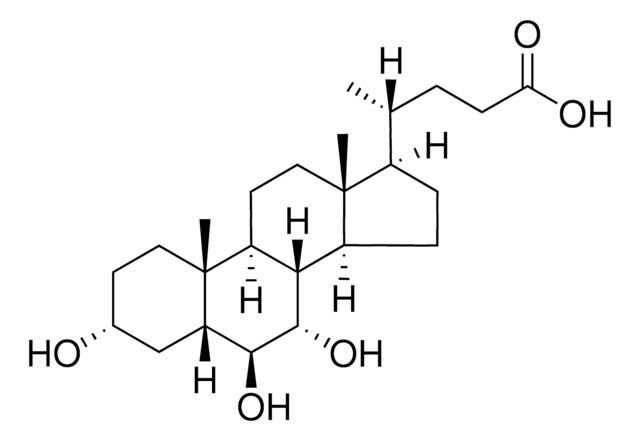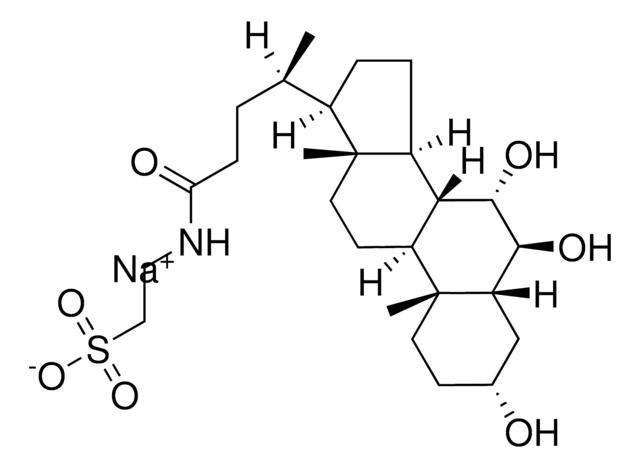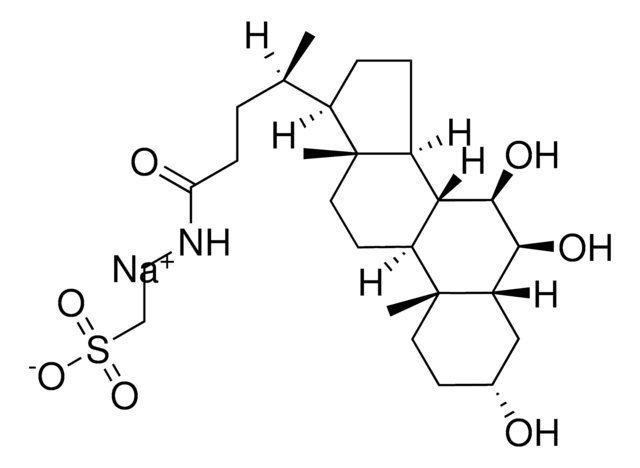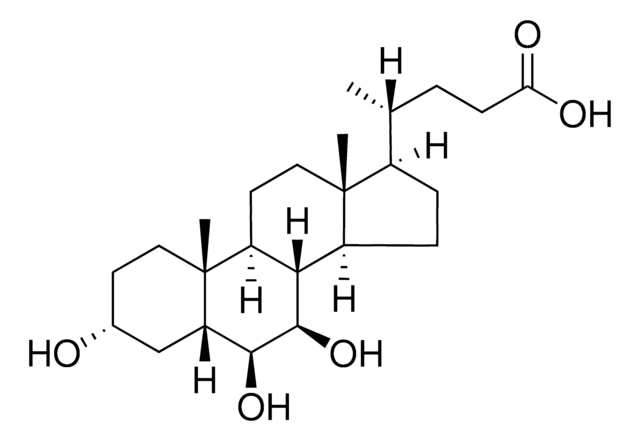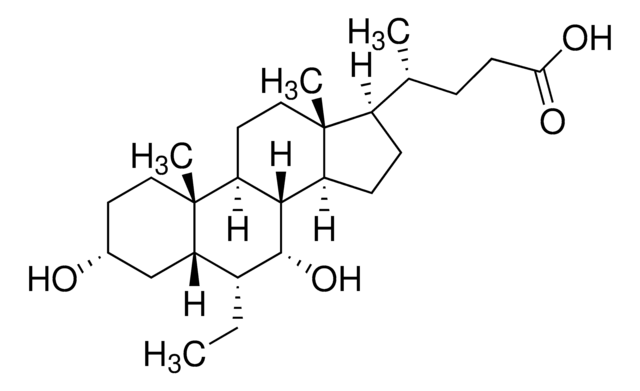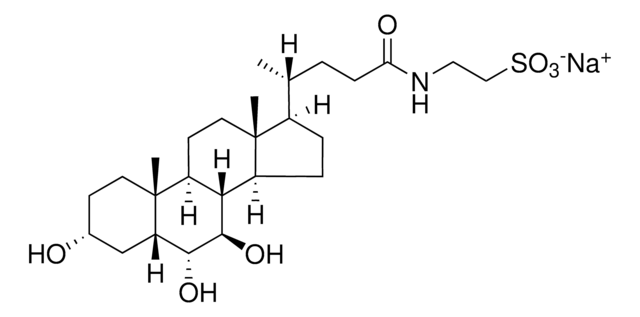추천 제품
분석
≥98% (HPLC)
형태
powder
광학 활성
[α]/D +59 to +65°, c = 0.5 in methanol
색상
white to beige
solubility
DMSO: 2 mg/mL, clear
저장 온도
−20°C
InChI
1S/C24H40O5/c1-13(4-7-19(26)27)15-5-6-16-20-17(9-11-23(15,16)2)24(3)10-8-14(25)12-18(24)21(28)22(20)29/h13-18,20-22,25,28-29H,4-12H2,1-3H3,(H,26,27)/t13?,14-,15?,16?,17?,18+,20?,21+,22-,23-,24-/m1/s1
InChI key
DKPMWHFRUGMUKF-CWNVCPLQSA-N
애플리케이션
β-Muricholic Acid has been used as a bile acid to study its effects on the expression of pluripotency, stemness, and inflammatory genes in primary mouse hepatocytes (PMH) and tumor-initiating stem-like cells(TICs). It has also been used as a bile acid to study its effects on gut transit ingnotobiotic or conventional mouse models.
생화학적/생리학적 작용
β-Muricholic Acid is a naturally occurring trihydroxy hydrophilic bile acid that is produced in the liver of murine. It serves as a biliary cholesterol-desaturating agent and aids in the dissolution of cholesterol gallstones.
β-Muricholic acid (β-MCA) is a natural murine-specific bile acid. β-Muricholic acid has been shown to reduce the absorption of cholesterol. It also has some activity as a farnesoid X receptor antagonist.
Storage Class Code
11 - Combustible Solids
WGK
WGK 3
Flash Point (°F)
Not applicable
Flash Point (°C)
Not applicable
시험 성적서(COA)
제품의 로트/배치 번호를 입력하여 시험 성적서(COA)을 검색하십시오. 로트 및 배치 번호는 제품 라벨에 있는 ‘로트’ 또는 ‘배치’라는 용어 뒤에서 찾을 수 있습니다.
이미 열람한 고객
Laura Conde de la Rosa et al.
Journal of hepatology, 74(6), 1429-1441 (2021-01-31)
Besides their physiological role in bile formation and fat digestion, bile acids (BAs) synthesised from cholesterol in hepatocytes act as signalling molecules that modulate hepatocellular carcinoma (HCC). Trafficking of cholesterol to mitochondria through steroidogenic acute regulatory protein 1 (STARD1) is
Kyosuke Fujita et al.
Lipids, 52(4), 335-344 (2017-03-21)
The farnesoid X receptor (FXR) is a major nuclear receptor of bile acids; its activation suppresses sterol regulatory element-binding protein 1c (SREBP1c)-mediated lipogenesis and decreases the lipid contents in the liver. There are many reports showing that the administration of
David Q-H Wang et al.
Journal of lipid research, 43(11), 1960-1968 (2002-10-29)
This study investigated whether beta-muricholic acid, a natural trihydroxy hydrophilic bile acid of rodents, acts as a biliary cholesterol-desaturating agent to prevent cholesterol gallstones and if it facilitates the dissolution of gallstones compared with ursodeoxycholic acid (UDCA). For gallstone prevention
Ylva Bonde et al.
PloS one, 11(1), e0147772-e0147772 (2016-01-30)
High endogenous production of, or treatment with muricholic bile acids, strongly reduces the absorption of cholesterol. Mice abundant in muricholic bile acids may therefore display an increased resistance against dietary induced weight gain, steatosis, and glucose intolerance due to an
Xiaobei Pan et al.
Metabolites, 7(2) (2017-06-21)
Certain endogenous bile acids have been proposed as potential therapies for ameliorating Alzheimer's disease (AD) but their role, if any, in the pathophysiology of this disease is not currently known. Given recent evidence of bile acids having protective and anti-inflammatory
자사의 과학자팀은 생명 과학, 재료 과학, 화학 합성, 크로마토그래피, 분석 및 기타 많은 영역을 포함한 모든 과학 분야에 경험이 있습니다..
고객지원팀으로 연락바랍니다.